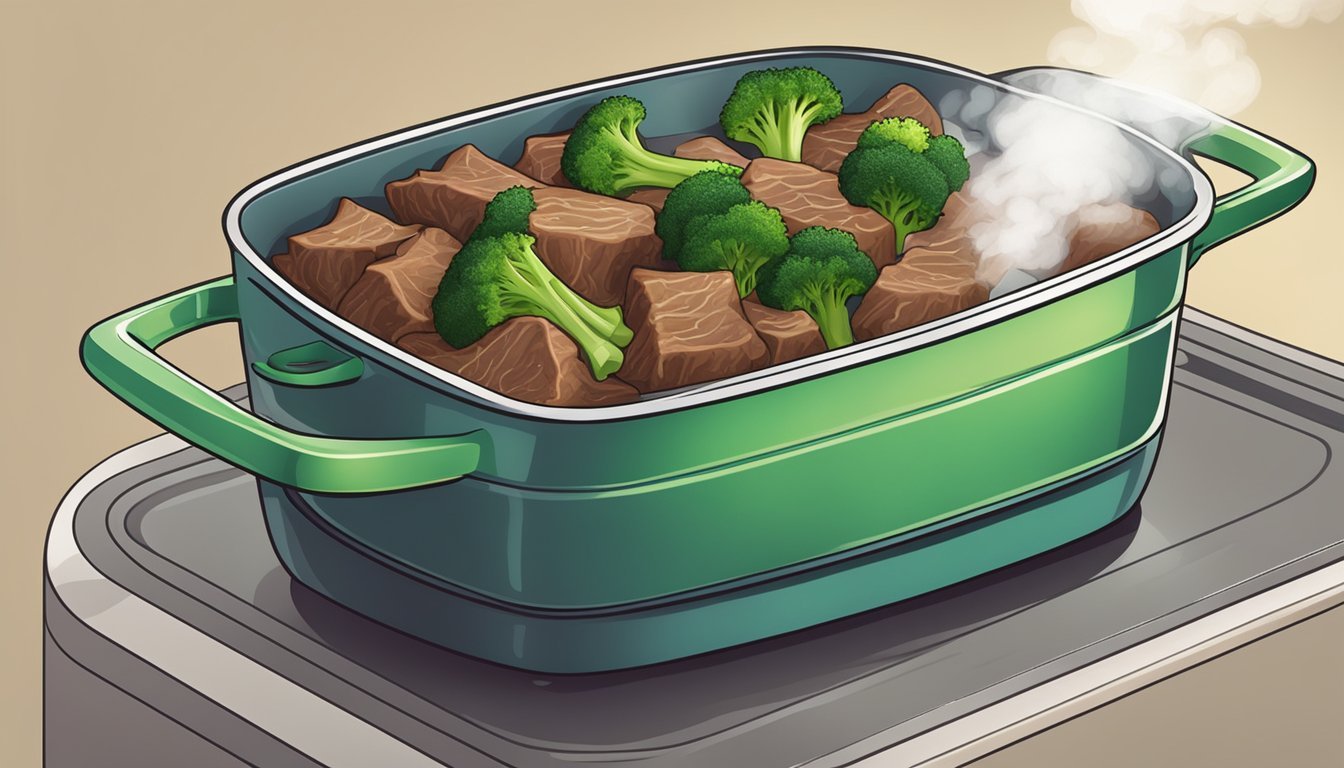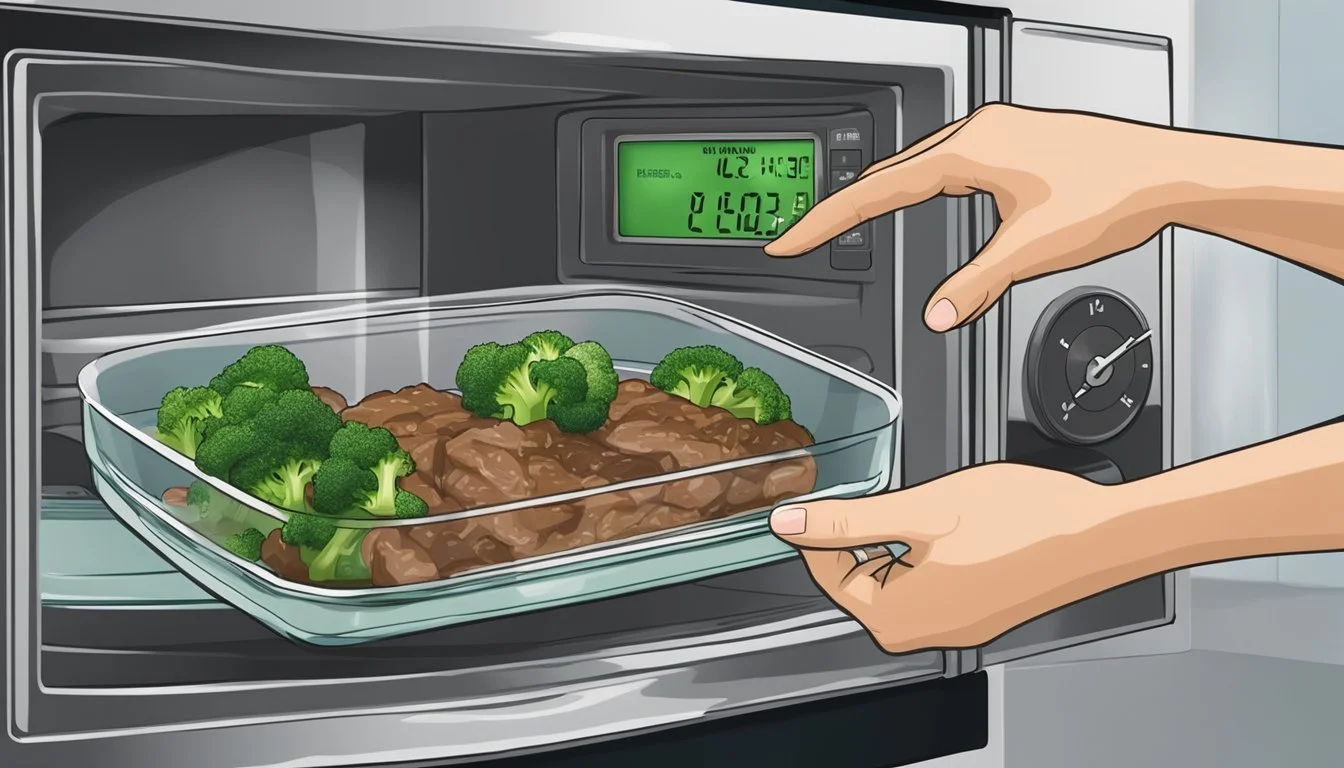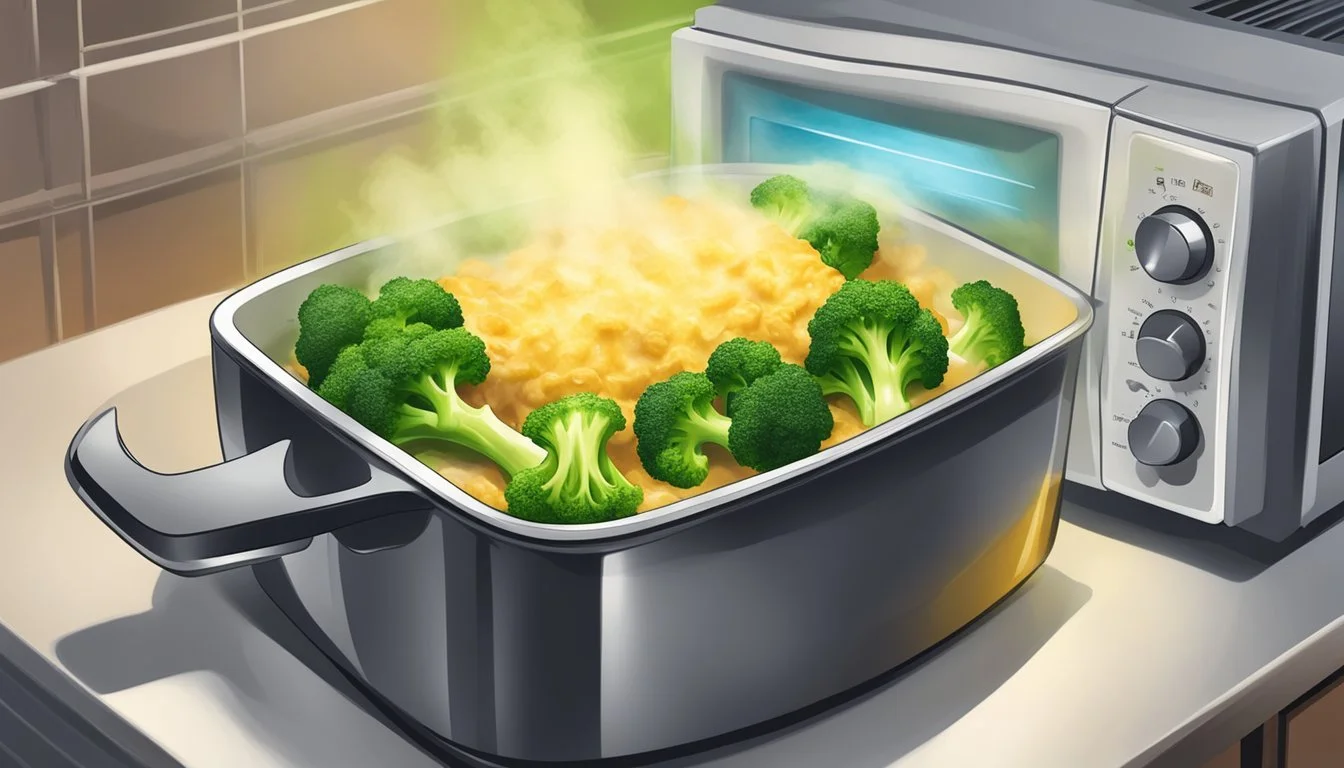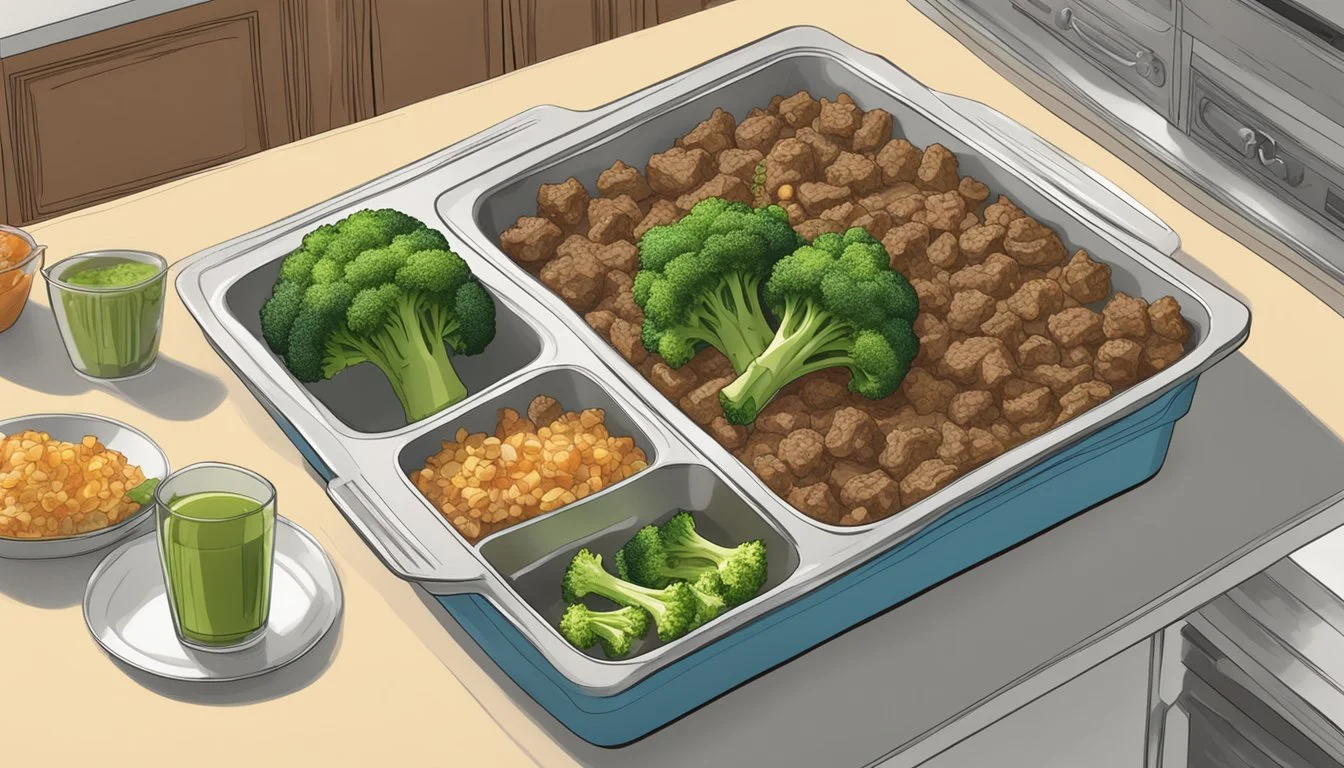How to Reheat Beef and Broccoli Casserole
Step-by-Step Guide
Reheating beef and broccoli casserole to retain its delicious taste and texture can be a challenge, but it's entirely possible with the right methods. The best way to reheat a beef and broccoli casserole is to use an oven, which ensures even heating and helps keep the casserole moist. By preheating the oven to 350°F (175°C), placing the casserole in an oven-safe dish, and loosely covering it with aluminum foil, the leftovers can be warmed up perfectly without drying out.
For those short on time, the microwave offers a quick and efficient solution. Place a portion of the casserole in a microwave-safe dish, cover it with a moist paper towel, and heat it in intervals, turning the pieces as needed to promote even reheating. This method helps maintain the casserole's texture, ensuring every bite is just as satisfying as when it was freshly cooked.
Regardless of the method chosen, the key to successfully reheating beef and broccoli casserole lies in careful attention to temperature and moisture retention. These techniques will help transform leftovers into a delightful meal once again.
Understanding Casserole Reheating Basics
Reheating a casserole like beef and broccoli requires attention to food safety, moisture retention, and preventing texture degradation.
Food Safety Considerations
When reheating casseroles, it is critical to ensure they reach a safe internal temperature. The USDA recommends heating food to 165°F (74°C) to eliminate bacterial risks. An instant-read thermometer is essential for checking this temperature accurately.
Proper storage before reheating also plays a significant role. Ensure the casserole has been cooled and stored in the refrigerator at or below 40°F (4°C). If the casserole has been frozen, thaw it in the refrigerator overnight for even reheating.
Avoid reheating casseroles multiple times, as repeated temperature changes can lead to bacterial growth and compromise food safety.
Moisture Retention Techniques
Maintaining moisture during reheating prevents the casserole from drying out. Cover the casserole with aluminum foil as it reheats to trap steam and retain moisture.
Adding a small amount of liquid, such as broth or water, can help keep the dish moist. For beef and broccoli casserole, a light drizzle of beef broth can enhance both flavor and moisture content.
Placing a moist paper towel over the top before covering it with foil can also be effective in retaining moisture.
Preventing Texture Degradation
The texture of beef and broccoli casserole can suffer during reheating if not managed properly. Use a moderate temperature, typically 350°F (175°C), to ensure even heating without overcooking.
Preheating the oven and removing the casserole from the fridge 30-60 minutes before reheating can help promote even heat distribution.
Avoid prolonged reheating times, which can cause the casserole to become mushy or dried out. Typically, reheating should take 20-30 minutes, depending on the size and thickness of the casserole.
Covering the casserole with foil during reheating helps maintain an ideal texture by preventing it from becoming too crispy or tough.
Preparing Your Casserole for Reheating
To reheat a beef and broccoli casserole effectively, it is important to follow essential steps such as thawing frozen portions correctly and dividing the dish for even heating.
Thawing Frozen Casserole
If the casserole has been stored in the freezer, proper thawing is crucial. Move the casserole from the freezer to the fridge approximately 24 hours before reheating. This slow defrosting method ensures even thawing and preserves the dish's texture.
For a quicker option, use the microwave's defrost setting. Place the casserole in a microwave-safe container and defrost in short intervals. Rotate or stir the casserole to ensure uniform defrosting. Avoid using hot water for defrosting as it can lead to uneven thawing and potential safety issues.
Portioning for Even Heating
To ensure that the beef and broccoli casserole heats evenly, consider portioning the dish before reheating. Smaller portions allow for quicker and more uniform heating. Cut the casserole into individual servings or smaller pieces that can be reheated separately.
Place portions in an oven-safe dish, ensuring they are not overcrowded. Preheat the oven to 350°F (175°C) and cover the dish with aluminum foil to retain moisture. Heat for 20-30 minutes, checking periodically. Use a food thermometer to confirm that the internal temperature reaches 165°F (74°C).
By implementing these steps, your reheated beef and broccoli casserole will be both safe to eat and delicious.
Selecting the Right Reheating Method
When it comes to reheating beef and broccoli casserole, choosing the appropriate method ensures the dish retains its flavors and textures. Understanding the benefits of each reheating strategy can help in making an informed decision.
Oven Reheating Strategy
Oven reheating is ideal for those who want to preserve the texture and moisture of their casserole. Set the oven to 350°F (175°C). Place the casserole in an oven-safe dish. If transferring from a different container, choose one that evenly distributes heat, such as glass or ceramic. Covering the dish with aluminum foil helps retain moisture while preventing it from drying out. Bake for about 20-30 minutes, checking occasionally to avoid overcooking. For best results, place the casserole on the middle rack to ensure even heating.
Microwave Reheating Tips
For quick and convenient reheating, the microwave is a practical choice. To ensure even reheating, set the microwave to medium heat. Transfer a portion to a microwave-safe dish if necessary. Cover the dish with a microwave-safe lid or wrap to retain moisture. Heat in short intervals, such as 2 minutes, stirring in between to avoid cold spots. If the casserole was frozen, defrost it first before reheating. This step can prevent uneven heating and help maintain the dish's quality.
Alternative Reheating Methods
Other reheating methods include using a skillet, stovetop, air fryer, toaster oven, or slow cooker.
Skillet: Place the casserole in a preheated skillet over medium heat. Stir occasionally until evenly heated.
Stovetop: Heat the casserole in a saucepan over low heat, stirring frequently.
Air Fryer: Set to 350°F (175°C). Use an oven-safe dish or foil. Reheat for 8-10 minutes.
Toaster Oven: Preferable for smaller portions. Set to 350°F (175°C). Heat for approximately 15-20 minutes.
Slow Cooker: For a more gradual reheating, set on low. Place the casserole in the cooker for 2-3 hours or until hot.
Each method has its unique benefits, offering flexibility based on the tools available and time constraints.
Step-by-Step Reheating Instructions
When it comes to reheating your beef and broccoli casserole, choosing the right method ensures that it remains moist and flavorful. Each method—oven, microwave, or stovetop/skillet—has its own steps and considerations to make reheating an easy task.
Oven Reheating Instructions
Preheat the Oven: Set your oven to 350°F (175°C).
Prepare the Dish: Transfer your beef and broccoli casserole to an oven-safe dish. If the casserole is cold, allow it to come to room temperature first.
Cover the Dish: Cover the dish with aluminum foil to retain moisture. This prevents the casserole from drying out while heating.
Bake: Place the covered dish in the preheated oven. Heat for about 25-30 minutes.
Check the Temperature: Use an oven thermometer to ensure the internal temperature reaches 165°F (74°C).
Microwave Reheating Instructions
Transfer to a Microwave-Safe Container: Move the portion of casserole you wish to reheat into a microwave-safe container.
Cover Loosely: Use a piece of microwave-safe plastic wrap or a microwave lid to cover the container loosely, allowing steam to escape.
Heat in Intervals: Set the microwave to medium power. Heat the casserole in 2-minute intervals, stirring in between to ensure even heating.
Temperature Check: Continue reheating until the internal temperature reaches 165°F (74°C). This usually takes about 4-6 minutes in total.
Let it Sit: Allow the casserole to sit for a minute or two before serving to let the temperature even out.
Stovetop and Skillet Warming Guide
Selection of Pan: Use a skillet or a large saucepan with a lid.
Add a Little Liquid: Add a small amount of broth or water to the pan to prevent the casserole from sticking and to add moisture.
Low to Medium Heat: Place the pan on the stovetop over low to medium heat.
Heat Gradually: Stir the casserole occasionally to ensure even heating. Cover with a lid to trap steam.
Cook Until Warm: Continue heating until the casserole reaches an internal temperature of 165°F (74°C), which may take around 10-15 minutes.
Enhancing Flavor and Texture Post-Reheating
To ensure the beef and broccoli casserole retains its delicious flavor and appealing texture after reheating, attention to moisture and topping crispiness is critical.
Adding Moisture with Broth
Reheating can often dry out casseroles. To combat this, adding chicken or vegetable broth is effective. Before reheating, drizzle a small amount of broth (about 1/4 cup) evenly over the casserole.
This helps to restore moisture lost during the initial cooking and storage.
Make sure the broth is well distributed to reach all parts of the dish. For best results, allow the casserole to rest at room temperature for a few minutes before placing it in the oven. This helps the liquid to penetrate deeper, enhancing overall flavor and juiciness.
Maintaining a Crispy Topping
The crispy topping is a key feature that adds texture contrast to the casserole. Covering the casserole loosely with aluminum foil during reheating can preserve this crispy layer. This keeps moisture in the lower layers while preventing the topping from becoming soggy.
If the topping includes cheese or breadcrumbs, consider adding a fresh layer before reheating to refresh its crunchiness.
Allow the casserole to reheat uncovered for the last few minutes, or use the broil setting for a short time. This helps the top layer attain a desirable crispiness without overcooking the rest of the dish.
Pro Tips for Storage and Prevention
Storing a beef and broccoli casserole properly and taking measures to avoid sogginess ensures that leftovers remain as delicious as the fresh dish. Here are some specific tips for effective storage and preventing moisture loss.
Effective Storage Solutions
Use Airtight Containers: Store leftover beef and broccoli casserole in airtight containers. This helps retain freshness and prevents the casserole from absorbing any odors from the fridge.
Choose the Right Container: Opt for glass or high-quality plastic containers that are free of BPA. These materials are more effective at preserving the casserole's texture and flavor compared to other options.
Label and Date: Always label and date your containers. This practice helps in keeping track of how long the leftovers have been stored, ensuring they are consumed within a safe period.
Proper Layering: If the casserole has multiple layers, try to maintain those layers when storing. This will help in preserving the original structure and taste when you reheat it.
Refrigerate Promptly: Place the casserole in the refrigerator within two hours of cooking to minimize bacterial growth.
Preventing a Soggy Casserole
Cover Carefully: When wrapping the casserole for storage, avoid using too many layers of plastic wrap, as it can trap too much moisture. Instead, a loose cover with foil or a well-fitting lid can help balance moisture retention.
Moisture Control: Adding a paper towel between the casserole and the cover can help absorb excess moisture, preventing the casserole from becoming soggy.
Avoid Overpacking: Do not overfill containers. Overpacking can lead to uneven reheating and excess moisture buildup, resulting in a soggy texture.
Check Moisture Levels: Before reheating, visually inspect the casserole. If it appears too dry, add a few teaspoons of water or broth. If it's too wet, try reheating without a cover for the first 10 minutes to let some moisture evaporate.
Prevent Freezer Burn: If freezing the casserole, ensure that it is wrapped tightly in plastic wrap and then in foil or placed in a freezer-safe container to prevent freezer burn.
These tips help ensure that your beef and broccoli casserole stays flavorful and delicious even after storage.
Casserole Variations and Considerations
Different types of casseroles may require slight adjustments in reheating to ensure they remain delicious and maintain their texture. Below are tailored techniques for various popular casserole variations.
Adapting Techniques for Different Casseroles
Breakfast Casserole: Breakfast casseroles often contain eggs, sausage, and cheese. To reheat, preheat the oven to 325°F. Cover the dish with aluminum foil to retain moisture and prevent over-browning. Bake for 20-25 minutes. For an even heat, consider stirring halfway through the reheating time.
Taco Casserole: This type of casserole includes layers of taco meat, beans, and cheese. Preheat the oven to 350°F. Place the taco casserole in an oven-safe dish and cover it with foil. Bake for 25-30 minutes. For a crispy top, remove the foil during the last 10 minutes.
Veggies: Casseroles heavy on vegetables, like broccoli, can dry out. Preheat the oven to 350°F. Cover the dish with foil and add a bit of water or broth. Bake for 20-25 minutes, checking halfway through to ensure the veggies don't get mushy.
Cheesy Topping: For casseroles with a cheesy top, preheat the oven to 350°F. Cover loosely with foil to focus on reheating the bottom layers without melting or burning the top cheese layer too quickly. Bake for 20-30 minutes, removing the foil for the last 5 minutes to re-crisp the cheese.






